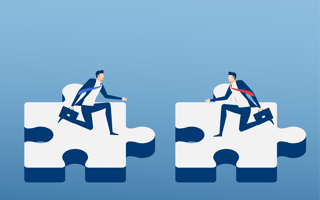When building a product, it’s best to imagine design and engineering teams at opposite ends of Newton’s cradle. Both are inputting energy back and forth in order to contribute and generate progress on a project, but if either team falls out of sync along the way, they end up derailing momentum and accomplishing nothing.
Issues among designers and engineers can arise for a variety of reasons. Between individual project goals, diverse tech stacks and separate vocabularies, it’s easy to lose sight of the overall mission: to improve the experience for your customers. That’s why establishing a seamless method of collaboration between both parties from initial brainstorming through final deliverance is crucial to a product’s success and eliminating any unnecessary friction.
“The most basic but impactful best practice we follow is to ensure design is included in the engineering scrum at least once a week,” said Jeremy Pallai, VP of digital product and design at Ollie. “If this isn’t happening, it is likely that the dev and design cycle is too far out of sync.”
In order to find out how leaders are best aligning their company’s design and engineering teams, Built In NYC turned to Pallai and Galileo’s Director of Product Design Denny McFadden for some valuable insight. The two design experts revealed the biggest challenges they’ve faced while trying to improve connection between departments and the most effective strategies that have kept both internal teams swinging efficiently in tandem.
What is the biggest challenge you see designers and engineers run into when working together?
It’s no surprise that designers can feel stifled by tech limitations. This normally sounds something like, “We’d love to do X, but X will take way too long, so let’s settle for Y.” If engineering is seeing the designs for the first time during handoff — or worse, within a Jira ticket with no handoff at all — more often than not you’ll end up with major reworking that will derail the sprint.
At Ollie, we’ve found success in building more cross-functional collaboration into the early stages of the design process. Engineers participate heavily in design reviews to shed light on hidden complexity and offer new solutions we might not have considered.
From an engineering perspective, it can be frustrating when not all critical scenarios are considered or reflected in designs. You’ve probably seen this before: The “happy path” is perfectly mapped out in Figma but that’s a small part of the overall change footprint. This anti-pattern causes delays for the engineering team and turns into a series of last-minute requests that boomerang into the design sprint. At Ollie, our product and design team builds story map visuals to show various states and click patterns for both happy and grumpy paths.
Designers and engineers bring very different perspectives to the work they do. What can these teams do to better understand each other’s space?
For our pack at Ollie, the most basic but impactful best practice we follow is to ensure design is included in the engineering scrum at least once a week to gain context, share updates and answer questions. If this isn’t happening, it is likely that the dev and design cycle is too far out of sync. The Ollie engineering team is aspiring to take this a step further and involve design more often in backlog grooming. This way, design sees what the acceptance criteria is for each story, and product can request any missing designs well out in front of a sprint.
We’ve found success in building more cross-functional collaboration into the early stages of the design process.”
What’s a strategy you’ve found to be particularly effective for creating and maintaining alignment among teams?
We’ve found that a powerful way to build shared context, trust and alignment is to invest in the creation of your brand’s design system. This tool is not only a game-changing asset for quality, consistency and speed, but the discussion and decisions required to finalize these components are a significant bonding opportunity for the design and engineering teams.
At Ollie, we believe that our design system, aptly called Fetch, is a shining example of how shared ownership and accountability can work. Each time a new component, pattern or interaction is considered, it empowers designers and engineers to hash out what’s best for Fetch and our pet parent users. If you continue to innovate, the work on the design system is never finished — it’s an investment you can’t afford to overlook.
What is the biggest challenge you see designers and engineers run into when working together?
One aspect of the design and engineering partnership that can be challenging is that these roles often operate with conflicting constraints when solving problems together. To overcome this, we believe it’s vitally important for leads to be present throughout the entire shaping cycle. This means that tech leads participate in early ideation sessions where they are exposed to stakeholder input. Designers are embedded in the engineering process — scrums, sprint planning, retros and so on — where they are expected to have a comprehensive understanding of front-end frameworks and at least cursory knowledge of our database and various integrations.
Designers and engineers bring very different perspectives to the work they do. What can these teams do to better understand each other’s space?
In my experience, designers often approach problem solving by going broad and then narrowing in while engineers like to start small, focus on distinct bits and then build out. This inversion frequently causes friction in early explorations. I think one of the most important things teams can do to improve collaboration is to develop a communication framework that allows team members to quickly understand which level we’re operating on.
One of the most important things teams can do to improve collaboration is to develop a communication framework.”
What’s a strategy you’ve found to be particularly effective for creating and maintaining alignment among teams?
One strategy that we’ve found to be effective is creating opportunities for all team members to have direct exposure to our customers. Specifically, we have recurring shadowing sessions where any team member can drop in to experience a day in the life of a doctor, nurse, social worker or health advocate. This practice has enormous downstream benefits when product teams are debating solutions to ensure that our decision making is rooted in a customer-centric focus.









